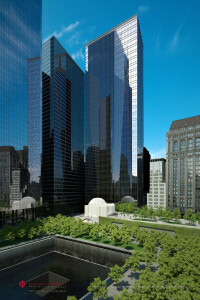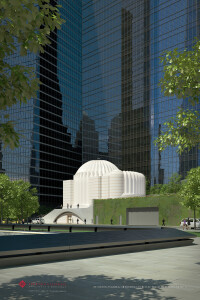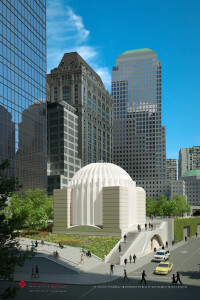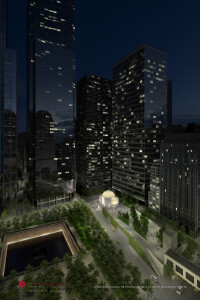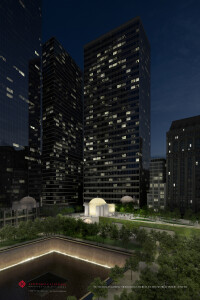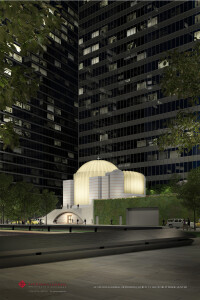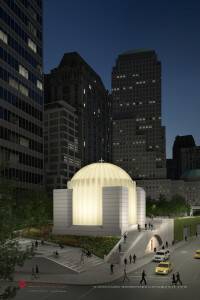From Inspiration to Rendering: The Architecture of the Saint Nicholas National Shrine
“The design is a tribute to the glorious beauty of Orthodox Christianity, of Hagia Sophia and Chora, as well as an acknowledgment of the present reality of a cosmopolis in the twenty-first century. May countless pilgrims gather here in peace and concord, to recall the past with reverence and envisage the future with hope.” - His All-Holiness Ecumenical Patriarch Bartholomew
The original St. Nicholas Greek Orthodox Church cast a reverent and faithful shadow on the World Trade Center. Greeks purchased the row house in 1892 as a community home, and it became the Saint Nicholas Church in 1916. For many Greeks immigrants, it would have been their first stop after seeing the Statue of Liberty and disembarking from Ellis Island. The little church was a spiritual jewel, open to all. Generations of New Yorkers stopped in to light a candle, say a prayer, or just sit quietly.
Everything changed on 9/11. Saint Nicholas was completely destroyed in the collapse of World Trade Center Tower Two during the September 11, 2001 terrorist attacks. During the weeks and months that followed, there were funerals and memorials for the many Greek Orthodox Christians who died that fateful day, as well as interfaith and ecumenical events, at city, state and national levels.
And most importantly for Saint Nicholas, the only house of worship destroyed on 9/11, the Archdiocese inaugurated a dialogue with then Governor George Pataki to rebuild the church.
The St. Nicholas National Shrine at the World Trade Center is being built directly across from the National September 11 Memorial and Museum and will overlook the 9/11 memorial.
In the years following, as the rebuilding of the World Trade Center took shape, there were challenges to keep the Church as a priority for the site (16 acres), since it was virtually a sliver a land. Due to changes at the site, it was proposed that the Church be relocated to 130 Liberty Street, a short walk from its original location. Even when negotiations stalled, governmental authorities always affirmed the right of the Church to be rebuilt.
When New York Governor Andrew Cuomo took office, a new opportunity arose to meet the impasse. His office mediated settlement discussions that confirmed the site at 130 Liberty Street. Following the signing of an agreement, the Archdiocese commenced a rigorous search for a design architect. A special committee was formed, including academic experts in Church Architecture, to interview a select group of firms with international reputations for excellence.
The design of the new St. Nicholas National Shrine is inspired by the architectural elements of the Cathedral Church of Hagia Sophia built by the Emperor Justinian and the Church of Our Savior in Chora. You can see specific inspirational elements of the two Churches that were key to the architecture of the St. Nicholas National Shrine at the World Trade Center. To enlarge the conceptual sketches and renderings, please use your mouse to click on a photo and then use the arrows to scroll through the gallery.
The Architecture of the St. Nicholas National Shrine
In the end there was an overwhelming consensus in favor of the design of Santiago Calatrava. He developed his plan from a wealth of Byzantine precedents, including the famous Church in Chora and Hagia Sophia itself. At the top of this page, you can see how his artistic inspiration for the design emerged from the mosaics of Hagia Sophia. The renderings presented here not only show its appearance, but its relationship to its environment. It is clear that the Church will be a lamp on a lampstand, and a city set on a hill (cf. Matthew 5:14,15)
The tradition of hospitality that Saint Nicholas exemplified throughout the twentieth century will continue at the new location. There will be a Meditation/Bereavement space and a Community room, housed in the upper levels above the Narthex, to welcome visitors and faithful.
The parish will continue to function as a parish of the Archdiocese, but it will also be a National Shrine on hallowed ground. The scope of its mission will span the globe, as millions of visitors to the Ground Zero memorials and museum pass by it every year. Its doors will be open to all to light a candle, say a prayer, or just sit quietly. It will shine as a spiritual beacon of hope and rebirth to cherish the memory of those who were lost that fateful day, and to build a better future for generations yet to be born.
View the future Saint Nicholas National Shrine in this high definition virtual tour of the facility. The interior views are approximated, as the video was made before the final iconographic program was established.

